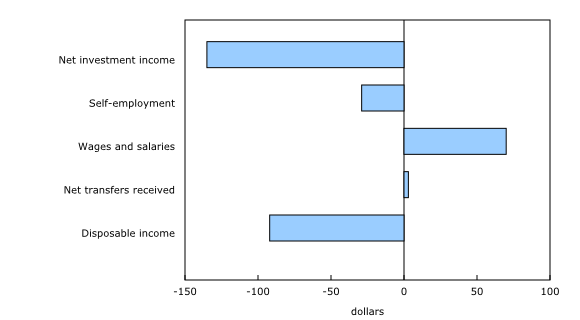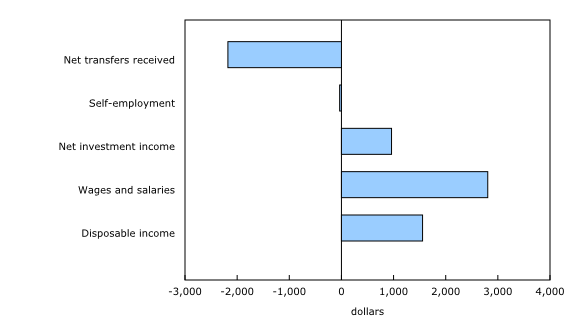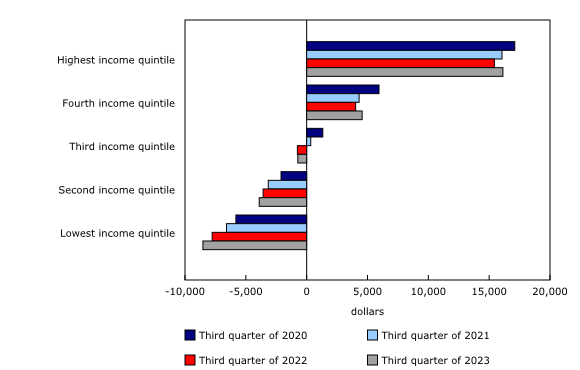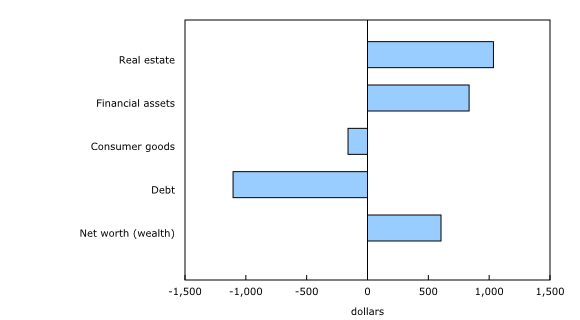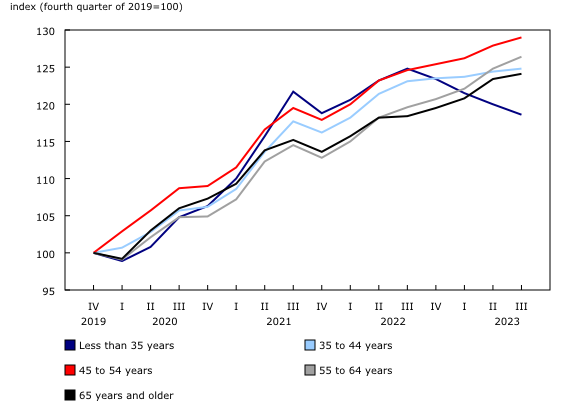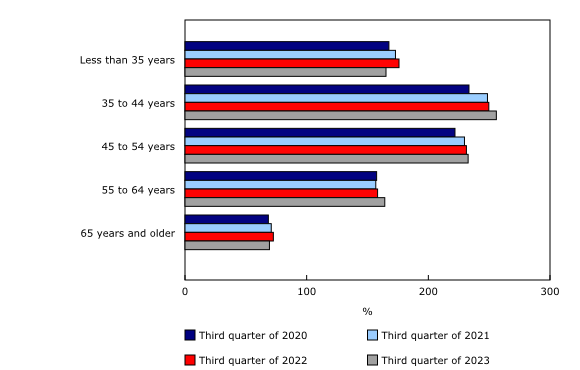Distributions of household economic accounts for income, consumption, saving and wealth of Canadian households, third quarter 2023
Released: 2024-01-22
The income and wealth gaps increased in the third quarter of 2023 relative to the same period a year earlier as higher interest rates had a negative impact on the income and net worth of the lowest income and least wealthy households.
Income gap widens as higher interest rates reduce income for lowest income households
Income inequality increased in the third quarter as the gap in the share of disposable income between households in the two highest income quintiles (top 40% of the income distribution) and two lowest income quintiles (bottom 40% of the income distribution) reached 44.9%, up 0.5 percentage points from the third quarter of 2022.
The lowest income households—those in the bottom 20% of the income distribution—were the only income group to reduce their average disposable income in the third quarter of 2023 relative to the same quarter of 2022 (-1.2%). Gains in average wages and salaries for the lowest income households (+3.0%) were more than offset by reductions in net investment income (-43.4%).
While higher interest rates can lead to increased borrowing costs for households, they can also lead to higher yields on saving and investment accounts. The lowest income households are more likely to have a limited capacity to take advantage of these higher returns, as on average they have fewer resources available for saving and investment.
Higher interest rates weighed on average disposable income for the lowest income households in the third quarter. Along with a doubling of the Bank of Canada's policy interest rate from 2.5% in July 2022 to 5.0% as of July 2023, net investment income declined for the lowest income households in the third quarter of 2023 relative to a year earlier. The lowest income earners reduced their net investment income as increased interest payments, more than half of which was due to consumer credit, outweighed gains in investment earnings.
Highest income households gain the most from wages and investment income
Average disposable income for the highest income households (top 20% of the income distribution) (+3.2%) increased at the fastest pace of any income group in the third quarter of 2023 relative to a year earlier, due entirely to gains in wages (+5.7%) and net investment income (+9.9%).
The highest income households were the only group to increase their net investment income, as gains in investment earnings were greater than increases in interest payments in the third quarter of 2023. Almost 75% of the increase in interest payments for the highest income households was due to mortgage debt, compared with less than half for the lowest income households.
Lowest income households' net saving declines as cost-of-living increases outweigh income gains
In contrast with a 4.6% gain in net saving for the highest income households, net saving for the lowest income households decreased by 9.8% in the third quarter of 2023 relative to a year earlier. For the lowest income households, cost-of-living increases outpaced income gains, especially for transportation, health, and housing.
Wealth gap widens as financial asset gains benefit wealthiest
Most wealth is held by relatively few households in Canada. The wealthiest (top 20% of the wealth distribution) accounted for more than two-thirds (67.4%) of net worth in the third quarter of 2023, averaging $3.3 million, while the least wealthy (bottom 40% of the wealth distribution) accounted for 2.8%, averaging $67,738.
The gap in wealth between the top 20% and the bottom 40% increased by 0.2 percentage points from the third quarter of 2022 to reach 64.6% in the third quarter of 2023 as gains in the average value of financial assets (+2.7%) counteracted muted growth in real estate values (+0.7%). More than half (56.3%) of asset holdings for the wealthiest were in the form of financial assets, compared with less than one-third (28.2%) for the least wealthy.
Net worth for the least wealthy increased by 0.9% in the third quarter of 2023 relative to the same quarter a year earlier, less than half the rate of increase observed for the wealthiest (+2.0%).
Least wealthy have weakest net worth growth as mortgage debt offsets real estate gain
Although the least wealthy held and acquired real estate, their average net worth was relatively unchanged in the third quarter of 2023 compared with a year earlier, as the increase in mortgage debt to finance those assets (+1.7%) offset the increase in the value of their real estate holdings (+1.1%), while financial asset values increased 1.8%. On average, real estate prices were stable (+0.3%) in the third quarter of 2023 relative to a year earlier.
In contrast with the least wealthy, the wealthiest (top 20%) increased their net worth at the fastest pace of any household group (+2.0% vs. +1.7% for all households) in the third quarter, derived mainly from financial asset gains (+3.0%). The average value of real estate for the wealthiest increased by 0.7% over the same period, the same rate observed for the average household. Meanwhile, debt was relatively stable, growing by 1.2% as the wealthiest avoided higher levels of borrowing.
Youngest households' mortgage debt declines along with mounting affordability concerns
Along with rapid interest rate increases from the third quarter of 2022 to the third quarter of 2023, the youngest households were the only age group that reduced their average mortgage debt (-5.0% vs. +1.3% for all households).
Households in the youngest age group—those aged less than 35 years—may be reducing their mortgage balances for various reasons. Prospective homeowners may be turning away from the housing market due to affordability concerns, while existing homeowners who purchased a home when interest rates were much lower a few years ago may be paying off their existing mortgage debt balances or moving into more affordable accommodations.
Youngest households' debt-to-income ratio declines, while debt service ratio increases
Debt-to-income ratios were the highest for core working-age households (aged 35 to 64) in the third quarter of 2023, ranging from 164.2% to 255.9%, and they also increased relative to a year earlier, especially those aged 35 to 44 years (+6.2 percentage points) and those aged 55 to 64 (+5.9 percentage points). Debt for core working-age households increased at a faster rate than disposable income, as employment income gains were offset by higher debt charges. Over the same period, the debt-to-income ratio declined for the youngest households (-10.7 percentage points for those aged less than 35 years) and seniors (-3.2 percentage points for those aged 65 years and older). While the ratio for the youngest households declined due to reductions in mortgage debt combined with strong wage gains, seniors benefitted from gains in investment earnings.
An alternative indicator of household financial risk is the interest-only debt service ratio (DSR), which is based on the value of total interest payments on credit market debt as a share of household disposable income. The DSR was higher for younger age groups in the third quarter of 2023, reaching 11.5% for those aged 35 to 44 years (+3.1 percentage points from the third quarter of 2022) and 9.7% for those aged less than 35 years (+2.4 percentage points).
Even though the decline in the debt-to-income ratio for the youngest age group indicates that they are carrying less debt, they continue to pay more to service their remaining debt due to increases in interest rates.
Persistently high interest rates and inflation are likely to continue to strain households' ability to make ends meet without going further into debt, especially vulnerable groups, such as those with the lowest income, the least wealth and in the younger age groups. The latest figures from the Monthly Credit Aggregates program indicate that household debt continued to grow up to November 2023, although there was a continued slowdown in mortgage borrowing as interest rates and relatively high home prices likely dissuaded buyers.
Did you know we have a mobile app?
Get timely access to data right at your fingertips by downloading the StatsCAN app, available for free on the App Store and on Google Play.
Sustainable Development Goals
On January 1, 2016, the world officially began implementation of the 2030 Agenda for Sustainable Development—the United Nations' transformative plan of action that addresses urgent global challenges over the next 15 years. The plan is based on 17 specific sustainable development goals.
The distributions of household economic accounts for income, consumption, saving and wealth of Canadian households are an example of how Statistics Canada supports the reporting on the Global Goals for Sustainable Development. This release will be used in helping to measure the following goal:
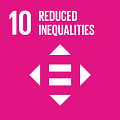
Note to readers
Statistics Canada regularly publishes macroeconomic indicators on household disposable income, final consumption expenditure, saving and wealth as part of the Canadian System of Macroeconomic Accounts (CSMA). These accounts are aligned with the most recent international standards and are compiled for all sectors of the economy, including households, non-profit institutions, governments and corporations along with Canada's financial position vis-à-vis the rest of the world. While the CSMA provide high quality information on the overall position of households relative to other economic sectors, the Distributions of Household Economic Accounts (DHEA) provide additional granularity to address questions such as vulnerabilities of specific groups and the resulting implications for economic well-being and financial stability. These estimates are an important complement to standard quarterly outputs related to the economy.
The DHEA estimates released today provide estimates of income, consumption, saving and wealth, including their sub-components by various household distributions up to the third quarter of 2023. Estimates have also been revised for prior periods to incorporate the latest CSMA benchmarks, including revisions back to the first quarter of 2020 for the income, consumption and saving series, and back to the fourth quarter of 2010 for the wealth series.
With this release, there are also updates to the Household Disposable Income (HDI) and Household Final Consumption Expenditure (HFCE) series to fully align with the Provincial-territorial Economic Accounts. These updates, which are minimal in nature, go back to 2010 for HDI and to 2006 for HFCE.
The term "income gap", referred to in this text, is defined as the gap in the share of disposable income between households in the top 40% and bottom 40% of the income distribution. The "wealth gap" is defined as the gap in the share of net worth between households in the top 20% and bottom 40% of the wealth distribution. Estimates for net worth distributed by wealth quintile are combined for households in the lowest two quintiles for ease of illustration, since the average household in the lowest wealth quintile owed more in liabilities than it owned in assets, such as self-employed workers with negative net business equity and recent graduates with student loan balances.
As with all data, the DHEA estimates are not without their limitations. While some distributions are estimated using timely microdata or micromodels, such as wages and salaries and household debt, other distributions, including those for household final consumption expenditures, social transfers in kind and assets rely on assumptions or use data from prior reference periods. Users should keep these limitations in mind when analyzing the estimates included in this release.
All values are expressed in nominal unadjusted rates. As a result, the estimates presented in this release are not adjusted for variations over time that may occur due to seasonal patterns and/or price inflation. Since the quarterly series are not seasonally adjusted, comparisons should only be made using estimates for the same quarter of each year.
Next release
Data on the Distributions of Household Economic Accounts for the fourth quarter of 2023 will be released on April 8, 2024.
Products
The data visualization product "Distributions of Household Economic Accounts, Wealth: Interactive tool," which is part of Statistics Canada – Data Visualization Products (71-607-X), is now available.
The article "Distributions of Household Economic Accounts, estimates of asset, liability and net worth distributions, 2010 to 2023, technical methodology and quality report," which is part of the Income and Expenditure Accounts Technical Series (13-604-M), is also available.
Details on the sources and methods behind these estimates can be found in Methodological Guide: Canadian System of Macroeconomic Accounts (13-607-X). See section "Distributions of Household Economic Accounts" under Satellite Accounts and Special Studies.
The Economic accounts statistics portal, accessible from the Subjects module of our website, features an up-to-date portrait of national and provincial economies and their structure.
The Latest Developments in the Canadian Economic Accounts (13-605-X) is available.
The User Guide: Canadian System of Macroeconomic Accounts (13-606-G) is available.
Contact information
For more information, or to enquire about the concepts, methods or data quality of this release, contact us (toll-free 1-800-263-1136; 514-283-8300; infostats@statcan.gc.ca) or Media Relations (statcan.mediahotline-ligneinfomedias.statcan@statcan.gc.ca).
- Date modified:

